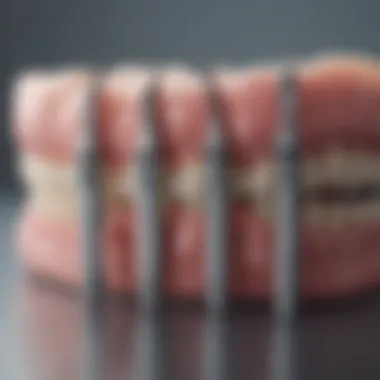Sickle Cell Disease and Dental Treatment Insights


Intro
Sickle cell disease (SCD) presents unique challenges in various aspects of healthcare, one of which is dental treatment. Patients with SCD often face complications that stem not only from their condition but also from the treatments required to maintain oral health. This interplay between sickle cell disease and dental care is crucial for professionals in the field to understand.
As we delve into this topic, we will highlight the specific medical considerations necessary for the effective management of dental treatment in patients with SCD. The intricacies of treatment protocols, patient interactions, and the implications of dental interventions will be explored in detail. Our aim is to foster an advanced comprehension of these elements to improve the care provided to this vulnerable population.
An understanding of SCD's impact on oral health is essential for dental practitioners. The following sections will provide a comprehensive overview of the relevant research and methodologies pertaining to this topic.
Intro to Sickle Cell Disease
Sickle cell disease is a complex genetic disorder affecting millions worldwide, characterized by the abnormal shape of red blood cells. Understanding this disease is critical when discussing dental treatment. Patients with sickle cell disease face unique challenges, particularly in oral health. Their compromised immune system and various health complications necessitate tailored dental care approaches. This section aims to highlight the significance of recognizing sickle cell disease within the context of dental treatment, emphasizing its implications for patient management, treatment planning, and outcomes.
Definition and Overview
Sickle cell disease is a hereditary blood disorder caused by a mutation in the hemoglobin gene. This mutation leads to the production of hemoglobin S, which distorts red blood cells into a sickle shape. These sickle-shaped cells can obstruct blood flow, resulting in pain crises and organ damage. Symptoms often begin in early childhood and can range from mild to severe. Understanding the definition of sickle cell disease helps dental professionals anticipate potential complications during treatment.
Epidemiology and Demographics
Sickle cell disease primarily affects individuals of African, Caribbean, Mediterranean, and Middle Eastern descent. In the United States, approximately 100,000 individuals have the disorder, with higher prevalence in African Americans. Globally, millions are affected, particularly in areas with malaria. The epidemiological insight into sickle cell disease stresses the need for awareness and understanding among healthcare providers, including dental professionals.
Causes and Genetic Factors
The underlying cause of sickle cell disease is an autosomal recessive inheritance pattern. Affected individuals inherit two copies of the sickle cell gene, one from each parent. If one parent carries the gene, the child may be a carrier without symptoms. Genetic counseling is important for families affected by sickle cell disease to understand risks and management options. This knowledge is crucial for healthcare providers to offer informed care, particularly in the dental field where complications can arise.
Understanding Dental Health
Understanding dental health is crucial for individuals, especially those with specific health concerns like sickle cell disease. This section will delve into the significance of maintaining oral hygiene and awareness of common dental conditions. Proper dental health significantly influences the overall well-being of sickle cell patients, who often face unique challenges.
Importance of Oral Hygiene
Oral hygiene involves maintaining the health of the mouth through regular brushing and flossing. For sickle cell patients, this practice becomes even more essential. Due to their health condition, they may experience a compromised immune system. This vulnerability can lead to a higher risk of infections and oral diseases. Poor oral hygiene can exacerbate these issues, leading to complications that may further impact their general health.
Patients should engage in good oral hygiene habits, including:
- Regular brushing at least twice a day with fluoride toothpaste.
- Flossing daily to remove food particles stuck between teeth.
- Routine dental check-ups every six months, as recommended by their dentist.
Educating patients about the importance of these practices can prevent oral health issues, which are common in sickle cell disease patients.
Common Dental Conditions
Sickle cell disease can predispose patients to certain dental issues. Understanding these conditions helps in better management and prevention. Common dental conditions that these patients may face include:
- Tooth Decay: This occurs due to poor oral hygiene and is exacerbated by conditions like dry mouth, common in sickle cell patients.
- Gum Disease: Early-stage gingivitis can progress to more severe periodontitis if left untreated, causing tooth loss and infections.
- Oral Mucositis: This painful condition leads to inflammation and ulceration of the mouth due to complications from sickle cell disease treatments.
- Tooth Erosion: Frequent acid exposure from dietary habits can lead to enamel degradation, affecting teeth's structure and health.
Awareness of these common dental conditions plays a vital role in identifying problems early and promoting prompt treatment. Regular dental visits and open communication with dental professionals are important for managing these risks effectively.
Maintaining good oral health is not just about avoiding cavities; it is a crucial aspect of overall health for those with sickle cell disease.
Impact of Sickle Cell Disease on Oral Health
Understanding the impact of sickle cell disease on oral health is essential for both patients and healthcare providers. Sickle cell disease not only affects the blood and organs but has significant implications for oral health. The unique physiological changes caused by this disease can exacerbate existing dental issues and create new challenges. Patients may experience a range of oral complications, which can affect their quality of life.
Prevalence of Oral Health Issues
Research shows that individuals with sickle cell disease are at a higher risk of developing various oral health issues. These patients might face conditions such as dental caries, periodontal disease, and oral ulcers. Studies indicate that this population experiences a markedly increased prevalence of dental problems when compared to the general population. It is vital for dental professionals to understand this correlation to provide appropriate preventative care.


- Oral health issues commonly encountered include:
- Cavities
- Gingivitis
- Periodontitis
- Oral mucosal lesions
These conditions arise due to factors such as compromised immune function and vascular occlusions associated with sickle cell disease. Therefore, regular dental check-ups become even more critical for early intervention.
Link Between Sickle Cell and Tooth Decay
The relationship between sickle cell disease and tooth decay is noteworthy. Patients with this condition often experience a higher incidence of cavities. The sickle-shaped red blood cells can lead to less blood supply to the dental tissues, adversely affecting their health and resilience against decay. Additionally, frequent hospital visits and medications can contribute to dry mouth, leading to a further increase in the likelihood of caries.
- Factors contributing to tooth decay in sickle cell patients include:
- Decreased saliva production
- Dietary habits influenced by pain and illness
- Medication side effects that may alter oral environment
Awareness of these connections can empower dental professionals to take tailored approaches in managing oral health among sickle cell patients.
Effects of Sickle Cell on Gum Health
Gum health is significantly affected in patients with sickle cell disease. Periodontal disease is prevalent in these individuals, primarily due to the inflammatory responses triggered from the disease. The altered blood flow and increased inflammatory markers can lead to gum issues, exacerbating complications like gum bleeding and infections. It has been observed that preventive dental practices are often neglected due to the patient's overall health challenges.
- Effects on gum health include:
- Increased susceptibility to gingivitis
- Heightened risk of periodontitis
- Potential for tooth mobility
Consistent dental care becomes crucial to maintain gum health, ensuring that these patients do not suffer further complications that could lead to tooth loss. Regular communication between the patient's healthcare team and their dentist can facilitate a more comprehensive care plan.
Dental Treatment Considerations for Sickle Cell Patients
When treating patients with sickle cell disease, dental professionals must adapt their approach to address the unique challenges this condition presents. Understanding the intricacies of sickle cell disease is crucial for maximizing treatment efficacy while minimizing potential complications. This section discusses essential considerations for dental treatment, emphasizing pain management, scheduling, preventive care, and patient education.
Pain Management Strategies
Effective pain management is paramount for patients with sickle cell disease. These individuals often experience chronic pain crises, which can be exacerbated by anxiety related to dental treatments. Strategies for pain management should include:
- Assessment of Pain Levels: Before any procedure, it is vital to accurately assess the patient's current pain status, recognizing that they may have a low pain threshold.
- Use of Appropriate Medications: Non-steroidal anti-inflammatory drugs (NSAIDs) and opioids may be warranted. The dentist must collaborate with the patient's healthcare team to devise a tailored medication plan.
- Application of Local Anesthetics: Local anesthetics should be used liberally and carefully to ensure the patient remains comfortable during procedures.
- Anxiety Reduction Techniques: Relaxation techniques or sedation may be recommended as needed to alleviate anxiety, making the treatment experience more tolerable.
"Pain management in sickle cell patients is not just about pain relief; it’s about understanding their psychological needs as well."
Appointment Scheduling and Considerations
Scheduling dental appointments for patients with sickle cell disease requires a thoughtful approach. Certain factors should be considered:
- Timing of Appointments: Early morning or late afternoon appointments may be beneficial, as patients often feel strongest at these times.
- Duration of Visits: Shorter, more focused dental visits can help reduce fatigue and discomfort for the patient. It is crucial to avoid prolonged procedures that may exacerbate pain or cause unnecessary stress.
- Flexibility with Emergencies: Patients with sickle cell disease are at increased risk for dental emergencies. Dental professionals should offer flexible scheduling to accommodate unforeseen circumstances.
- Follow-up Coordination: Effective follow-up consultations should be arranged to monitor the patient's recovery and address any complications that may arise after treatment.
Preventive Care and Education
Preventive care is the cornerstone of effective dental management for patients with sickle cell disease. Ensuring patients understand the importance of oral hygiene can significantly impact their overall health. Key components of preventive care include:
- Regular Dental Check-ups: Frequent visits allow for early identification and management of oral health issues.
- Education on Oral Hygiene Practices: Dental professionals must educate patients about proper brushing, flossing, and mouthwash use to prevent dental caries and gum disease.
- Dietary Counseling: Advice on a balanced diet can help minimize the risk of tooth decay. Patients should be informed about the detrimental effects of sugary foods and drinks on oral health.
- Collaboration with Healthcare Providers: Dentists should communicate regularly with the patient’s primary care physician to coordinate care plans that reflect the patient's unique health considerations.
In summary, addressing dental treatment considerations for patients with sickle cell disease requires a holistic understanding of their needs. Emphasizing pain management, appropriate scheduling, and preventive care can greatly enhance the patient experience and maintain optimal oral health.
Challenges in Dental Management
The intersection of sickle cell disease and dental care presents significant challenges that warrant in-depth understanding. Effective dental management is not merely about addressing the immediate dental needs of patients; rather, it involves a careful navigation through unique health-related concerns germane to sickle cell disease. This understanding is pivotal for healthcare professionals aiming to provide optimal care for patients coping with this chronic condition.
The complexity of managing dental health in sickle cell patients reflects on multiple levels, including communication effectiveness, access to appropriate care, and the preparedness of dental professionals. A nuanced approach tackles these challenges, ultimately leading to improved patient outcomes.


Communication Barriers
Communication barriers can serve as a formidable obstacle in achieving effective dental care for patients with sickle cell disease. The primary challenge lies in the nuances of medical jargon that may not be familiar to the patient or their family. Such barriers can result in misunderstandings regarding treatment protocols, medication instructions, or even the patient’s own health conditions.
To enhance communication:
- Simplification of Language: Using plain language can facilitate better understanding.
- Active Listening: Dental professionals should encourage questions and ensure that patients feel comfortable discussing their concerns.
- Visual Aids: Employing diagrams or models may enhance understanding of complex procedures.
Effective communication not only improves patient satisfaction but also enhances compliance with treatment protocols and optimized care pathways.
Access to Dental Care
Access to dental care remains a critical issue, significantly impacting the oral health of patients with sickle cell disease. Geographic location, socioeconomic status, and systemic healthcare barriers can play a role in limiting opportunities for proper dental management. In many cases, patients may live in areas lacking specialized dental services that cater to the specific needs of sickle cell patients.
An emphasis on improving access can be achieved through:
- Mobile Clinics: These can deliver dental care directly to communities in need.
- Telehealth Options: Virtual consultations can bridge the gap for patients unable to travel.
- Collaborations with Healthcare Providers: Partnerships can help to streamline referral systems.
Moreover, increasing awareness among policymakers about the dental health needs of sickle cell patients is crucial for promoting equitable access.
Training and Awareness among Dental Professionals
The level of training and awareness among dental professionals significantly influences the quality of care delivered to sickle cell patients. Many practitioners may lack specific education related to the complexities of managing this chronic disease, leading to oversight in treatment approaches. Recognizing the symptoms of a sickle cell crisis is vital as these can heavily impact dental treatment decisions.
Continuing education initiatives play a core role in overcoming this gap. Suggested actions include:
- Incorporation of Sickle Cell Education in Curriculum: Dental schools should integrate sickle cell disease management into their training programs.
- Workshops and Seminars: Regular programs can raise awareness among practicing professionals about best practices for addressing the dental needs of sickle cell patients.
- Networking Opportunities: Encourage engagement among professionals to share experiences and strategies for managing challenging cases.
Through informed dental care, practitioners can significantly reduce both the physical and psychological burden placed on patients with sickle cell disease, fostering a collaborative healthcare atmosphere that prioritizes patient well-being and understanding.
Case Studies and Clinical Experiences
The examination of case studies and clinical experiences is vital in understanding the interactions between sickle cell disease and dental treatment. These studies provide concrete examples of how dental professionals navigate the complexities that sickle cell patients face during treatment. They serve as educational tools, shedding light on the optimal approaches and strategies that yield successful outcomes. By analyzing real-life scenarios, clinicians can refine their methods and ensure better care for individuals with this condition.
Moreover, the lessons learned from these clinical experiences can foster improvements in protocols and practices, ultimately elevating the quality of care within dental settings.
Successful Outcomes
Successful outcomes in dental treatment for patients with sickle cell disease can take many forms. These outcomes not only relate to the effectiveness of the treatment but also to the overall patient experience.
Key elements contributing to successful outcomes include:
- Personalized treatment plans: Tailoring dental care to recognize the specific needs and health status of the sickle cell patient helps mitigate complications.
- Effective communication: A transparent dialogue between dental teams, patients, and their families ensures that all parties are aligned on treatment goals and potential risks.
- Comprehensive pain management: Utilizing appropriate analgesics and strategies to manage pain can lead to positive experiences for patients, enabling them to cope with both dental procedures and their underlying condition.
Research has provided illustrative cases where meticulous planning and careful execution resulted in maintaining good oral health in sickle cell patients. These instances underscore the importance of multidisciplinary collaboration and the sharing of best practices among dental professionals.
Lessons Learned from Challenges
The experiences derived from challenges faced during dental treatment of sickle cell patients are equally informative. These lessons can help improve future approaches to care. Common challenges include:
- Managing acute crises: Sickle cell patients are prone to pain crises that can occur unexpectedly. Recognizing signs and preparing for potential complications during appointments is crucial.
- Limited access to care: Many patients in underserved regions struggle to access necessary dental services, highlighting the need for outreach and education efforts.
- Awareness and training of dental professionals: Ongoing education about the nuances of sickle cell disease for dental teams is essential. This ensures they understand how to adjust techniques and approaches to accommodate patients effectively.
By embracing the challenges and successful outcomes documented through case studies, dental professionals can develop adaptable methodologies. This reflects a commitment to not only enhance care for sickle cell patients but also establish a more comprehensive understanding of their unique needs.
Collaborative Approaches to Care
Collaborative approaches to care are critical in the context of sickle cell disease and dental treatment. Integrating multiple perspectives enhances patient outcomes and addresses the unique challenges these individuals face. Through cohesive teamwork, different professionals offer tailored solutions to manage patients' needs effectively. It involves not just dentists and healthcare providers but also specialists such as hematologists and nurses who understand the complexities of sickle cell disease.


An interdisciplinary care team comes together to share knowledge and experience. This collaboration can result in holistic treatment plans that consider the patient's medical history, specific risks, and overall well-being. In a dental setting, such teams can optimize management during procedures, especially for patients who might experience pain crises or other complications related to their condition.
"Effective collaboration leads to more comprehensive management of sickle cell patients, improving their dental health significantly."
Key elements of collaborative care include:
- Communication: Clear and open lines of communication among team members help in sharing key insights about the patient’s health. This ensures that all professionals are on the same page regarding treatment protocols.
- Coordination: Seamless coordination among team members enhances scheduling and follow-up appointments, ensuring that patients receive timely care.
- Education: Continuous education for both healthcare teams and patients is essential. This can include training sessions about sickle cell disease and its implications on dental health.
Benefits of collaborative care include:
- Improved patient comfort and trust, leading to better cooperation during dental procedures.
- Reduced risks, as multiple experts oversee the treatment process, addressing any emerging complications.
- Enhanced efficiency, which can decrease the duration of visits and the number of appointments needed for comprehensive care.
Considerations about collaborative approaches: It requires dedicated effort and a shared commitment to patient welfare. Team members must prioritize patient needs over their specialty's focus, fostering a culture of mutual respect. In many cases, establishing a cohesive approach necessitates breaking down traditional silos in healthcare, which can be challenging.
In summary, collaborative approaches in care for sickle cell disease involve bringing together diverse professionals to create a more effective and patient-centered treatment model. This strategy not only addresses immediate dental needs but also lays the foundation for improved long-term health outcomes, ultimately benefiting the patient as a whole.
Interdisciplinary Care Teams
Interdisciplinary care teams are pivotal in managing the unique needs of patients with sickle cell disease in dental settings. These teams typically consist of various professionals, including dentists, hematologists, dental hygienists, and pediatricians. Each member provides distinct insights that contribute to comprehensive care strategies. When working together, the team can effectively anticipate the challenges that sickle cell patients may face during dental procedures.
Functions of interdisciplinary teams include:
- Joint assessments: Conducting thorough evaluations that consider all health aspects, not just dental issues.
- Shared treatment plans: Developing unified strategies that incorporate prevention and treatment recommendations from multiple specialties.
- Crisis management: Preparing responses for emergencies that may arise due to the patient's condition, helping to mitigate risks involved with dental procedures.
Patient and Family Involvement
Engaging patients and their families in the care process is essential, particularly for those dealing with sickle cell disease. Active participation ensures that treatment plans are aligned with patient preferences and needs. Families often play a crucial role in managing the disease, providing emotional support, and handling logistics related to healthcare.
Ways to involve patients and families include:
- Educational initiatives: Offering resources and training sessions that inform families about the disease’s implications on oral health and treatment options.
- Feedback mechanisms: Encouraging patients and families to share their experiences with care providers, which can guide future interventions and improve care quality.
- Support groups: Facilitating connections with other families facing similar challenges, which can foster a sense of community and shared learning.
Incorporating patient and family involvement not only empowers individuals but also helps to tailor dental care strategies that resonate with their specific situations. This engagement can lead to heightened satisfaction with the treatment process and better adherence to care recommendations.
Future Directions in Research and Practice
The intersection of sickle cell disease and dental treatment is a multifaceted area requiring ongoing research and careful consideration. Current treatment strategies must evolve alongside advancements in both medical and dental fields. Investigating new methodologies can lead to better management of sickle cell disease in dental settings.
Emerging Treatments and Technologies
Recent advancements in medical technology and pharmaceuticals have the potential to significantly enhance the dental care provided to patients with sickle cell disease. Innovations such as gene therapy are being explored for their ability to address some of the root causes of sickle cell disease. This could lead to improved overall health, thereby reducing oral health complications related to the disease.
Additionally, advances in diagnostic tools, such as non-invasive imaging techniques, can enable dentists to detect oral issues earlier and with greater accuracy. This can lead to timely interventions and more personalized care plans. Emerging biocompatible materials used in restorations and other dental procedures may also help minimize complications associated with sickle cell disease, as these materials are designed to reduce inflammatory responses in patients.
"The integration of emerging technologies in dental practice can profoundly transform care delivery for patients with complex health issues, including sickle cell disease."
Advocacy for Improved Access to Care
Advocacy plays a critical role in ensuring that patients with sickle cell disease receive appropriate dental care. Barriers to access, such as socioeconomic challenges and a lack of understanding among dental professionals about the condition, need to be addressed. Raising awareness among dental educators and practitioners about sickle cell disease can lead to better preparedness in handling such patients.
Organizations that focus on sickle cell awareness can contribute to this cause by promoting education and accessibility. Campaigns that emphasize the importance of routine dental care for patients with sickle cell disease can help in reducing stigma and promoting regular visits to dental health professionals. Building partnerships between medical and dental communities can also foster holistic care approaches that cater to the unique needs of these patients.
Epilogue
The exploration of the intricate relationship between sickle cell disease and dental treatment reveals a significant area that demands attention. Patients with sickle cell disease frequently encounter unique challenges in dental care settings. Acknowledging their specific needs is essential for improving health outcomes.
Summary of Key Points
Sickle cell disease creates a range of oral health issues, including a higher prevalence of decay and gum disease. Effective pain management practices are crucial during dental procedures. Furthermore, timely appointment scheduling can minimize discomfort and complications. A focus on preventive care can significantly help avoid severe health problems. Collaboration among healthcare providers enhances patient outcomes through interdisciplinary care teams.
The Importance of Continued Education and Advocacy
Ongoing education for dental professionals is vital. Understanding the complexities of treating patients with sickle cell disease will lead to better health outcomes. Advocacy efforts can push for improved access to specialized dental care. This ensures that patients receive the treatment that accounts for their unique status. Raising awareness about the needs and rights of sickle cell patients in dental practice will ultimately lead to more patient-centered care.















